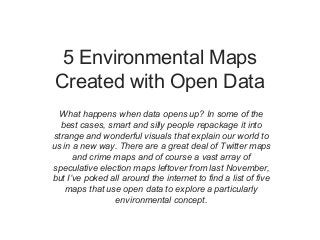
5 Environmental Maps Created with Open Data
- 1. 5 Environmental Maps Created with Open Data What happens when data opens up? In some of the best cases, smart and silly people repackage it into strange and wonderful visuals that explain our world to us in a new way. There are a great deal of Twitter maps and crime maps and of course a vast array of speculative election maps leftover from last November, but I’ve poked all around the internet to find a list of five maps that use open data to explore a particularly environmental concept.
- 2. 1. During Hurricane Sandy, New Yorkers were given the power of open data in the palm of their hands. Evacuation zones and other emergency information was made available through the city’s open data platform so that many users could make and disseminate their own maps, resulting in greater exposure.
- 3. 2. A better-designed parking system means less time circling the city looking for a place to park. San Francisco decided to meet their congestion problem by varying the charges for meters to meet peak demand. It’s novel and new and best of all, the city puts out a public API for developers to play with for future optimization. See all the pilot maps here: http://sfpark .org/wp-content/uploads/2012/11/RateChange8_All. pdf
- 4. 3. Here are two maps of the U.S. that tries the “good news, bad news” approach for environmental recognition. To find ways that all fifty states top and bottom out lists related to the environment, the Mother Nature Network used an impressive list of sources. Hey there Kentuckians--sorry to hear about your highest cancer death rate, but at least you have the longest cave!
- 5. 4. This is not the prettiest map on this list, but the bloggers at MappingLondon.co. uk used data from the Barclays bicycle share system and overlayed pollution data available from the city to identify where hired cycling and pollution interact.
- 6. 5. If population growth and carbon footprints keep you up at night, don’t look at these infographic- style maps. The Per Square Mile blog shows two important contrasts here: density and impact, in a way that poignantly illustrates the inequity of global lifestyles across different countries. The data comes from the Global Footprint Network.
- 7. Honorable Mention: The high-speed rail system that wasn’t While not made using open data information, the conception of how high-speed rail might look in the U.S. by Alfred Twu, captured the longings of many rail enthusiasts and flittered around the internet as a sad “what if”. Can maps change minds?